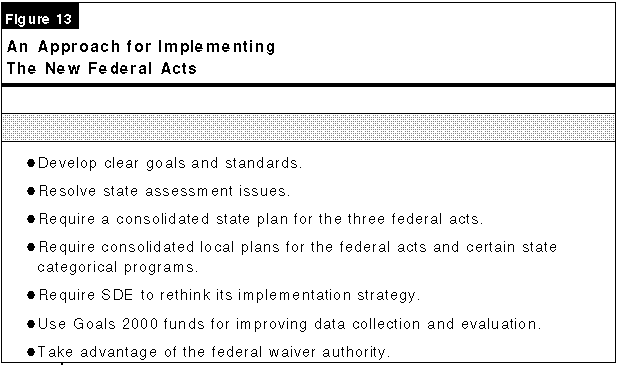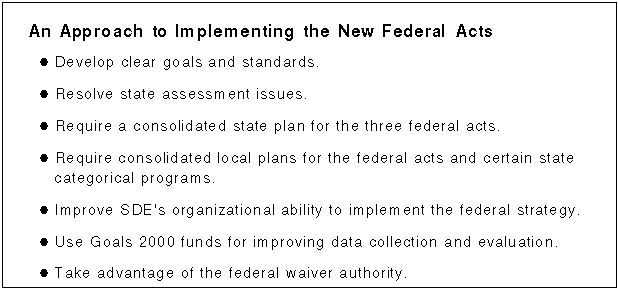
Introduction
The federal government has long sought to influence state and local education agencies to achieve specific policy goals. Federal programs for special education, compensatory education, vocational education, and child nutrition are among the targeted programs designed to remedy specific problems with state and local programs.
This report discusses issues involved in the implementation and coordination in California of three recently enacted federal education programs. This new federal legislation represents a mix of new programs and revised existing programs. The three acts are:
- Goals 2000: Educate America Act (Goals 2000) seeks "systemic" reform of the K-12 education system by (1) requiring states to establish specific goals for student learning and ways to measure whether that learning is taking place and (2) providing funds to local educational agencies (LEAs) to develop plans for meeting the state student achievement goals.
- The School-to-Work Opportunities Act (STWOA), which encourages reform primarily of high schools in order to increase student achievement at the high school level and help prepare students for high-skill, high-wage jobs upon graduation. The act provides five-year grants to states and LEAs to implement programs statewide. Ongoing support would be funded from existing state and federal resources.
- The Elementary and Secondary Education: Improving America's Schools Act (ESEA), which reauthorizes the ESEA. The ESEA contains funds for a variety of services for students with special needs, with the bulk of funding targeted for compensatory services to low-achieving students. Changes in the act reduce the federal role in prescribing the use of program funds, increase local accountability for improving student achievement, and emphasize the coordinated use of funding by LEAs.
New Directions in Federal Categorical Programs
The three new federal acts move in a number of new directions compared to previous federal programs. These new directions include:
- Improving the overall performance of public education rather than focusing on a narrowly targeted group of students.
- A new regulatory strategy based on performance instead of process.
- A common set of improvement strategies.
- A new emphasis on coordinating federal education programs at the state and local level.
- The state can take advantage of this new policy framework as a way to review and restructure the state's education system. The federal programs appear to be based on principles that are more likely than the current system to lead to long-term success in educating students. We believe the federal acts provide California an opportunity to rethink the state's role in education and its strategy for influencing LEA behavior through its regulation of local programs and through categorical programs, both state and federal.
Taking advantage of the federal framework is not risk-free, however. Concerns about federal intrusions into state and local education policy issues have been raised. For instance, while these federal education programs currently call for state-developed standards, some fear that this could change in the future.
Despite these types of concerns, we think the state could maintain adequate autonomy. For example, participation in Goals 2000, which requires states to set education standards, is voluntary. The state would always be able to opt out of Goals 2000 if it appeared federal policy making was interfering with state or local authority. (Of course, California would also have to relinquish the federal funds provided under Goals 2000, which would not be easy.)
On balance, we think the value of participating in these programs outweighs the potential risks. For this reason, we have explored the issues involved in the implementation and coordination of the three new federal education acts.
- First, we briefly describe each act and the amount of funding California can expect.
- Second, we discuss the policy framework created by the federal acts, the strengths of this federal policy framework, and some of the areas where additional work is needed.
- Third, we outline an approach to implementing these federal programs in California.
This report was prepared by Paul Warren. Sandra Russi prepared the report for publication.
Chapter 1
Goals 2000--State Standards, Local Improvement Activities
Goals 2000 is the centerpiece of the new federal legislation. The act contains three major provisions. First, the act sets out eight national education goals. Second, Goals 2000 requires states to develop a five-year improvement plan for achieving the national goals. Third, Goals 2000 creates local improvement grants to school districts to support planning and staff development activities needed to improve school performance.
National Education Goals
Goals 2000 establishes eight national education goals that states choosing to participate in the program are to pursue. To assist states in meeting these goals, the act provides funding and flexibility to waive federal rules that apply to a variety of federal education programs. The eight education goals are listed in Figure 1 (next page).
New Waiver Authority. An important new feature of Goals 2000 is broad new authority for the federal Secretary of Education to waive federal program rules and regulations that prevent effective delivery of services at the state and local level. All states may request specific, narrow waivers of six major federal education programs. In addition, under an "education flexibility" initiative in Goals 2000, up to six states may seek broad waivers that permit the state to design a program offering great flexibility to LEAs while creating accountability by monitoring student performance.

State Responsibilities
Under Goals 2000, states play a central role in interpreting the national goals to meet the state's educational needs, setting specific education goals, and in creating an environment in which local improvement efforts can succeed. Most of the state requirements must be addressed in a five-year state improvement plan. Figure 2 describes the major state responsibilities contained in Goals 2000. The mandated activities center around the state's responsibility to set student achievement goals in specific subject areas, create curriculum frameworks and assessments that are consistent with those achievement goals, and set student performance goals that define what level of student achievement is considered sufficient.
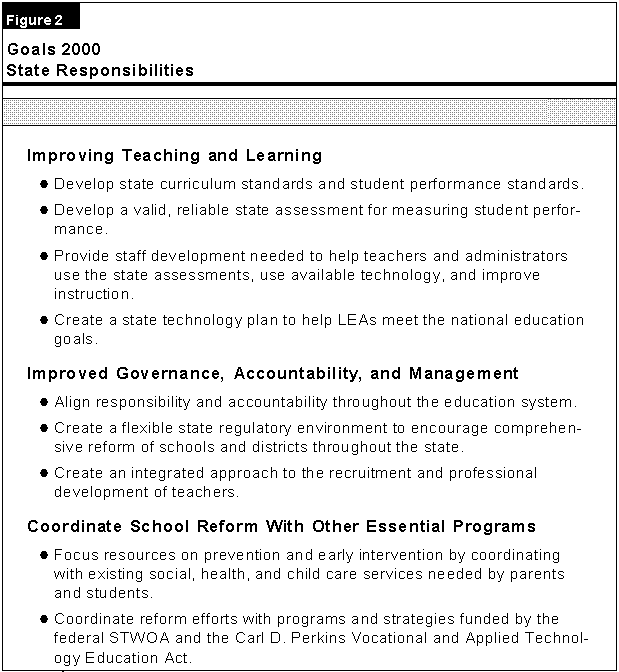
Goals 2000 gives states great latitude over the way the national goals will be pursued. There are no specific planning requirements for achieving the adult literacy goal, for instance. In addition, many of the state planning requirements do not mandate specific activities, calling instead for a state "strategy" for accomplishing the goals.
Local Responsibilities
While states are required to design the state improvement framework under Goals 2000, LEAs are charged with building on that state framework to improve the quality of education provided locally. Through a competitive grant process, states will distribute grants to LEAs for (1) local planning and (2) training and staff development. Figure 3 displays the activities eligible for funding under the two grant programs.
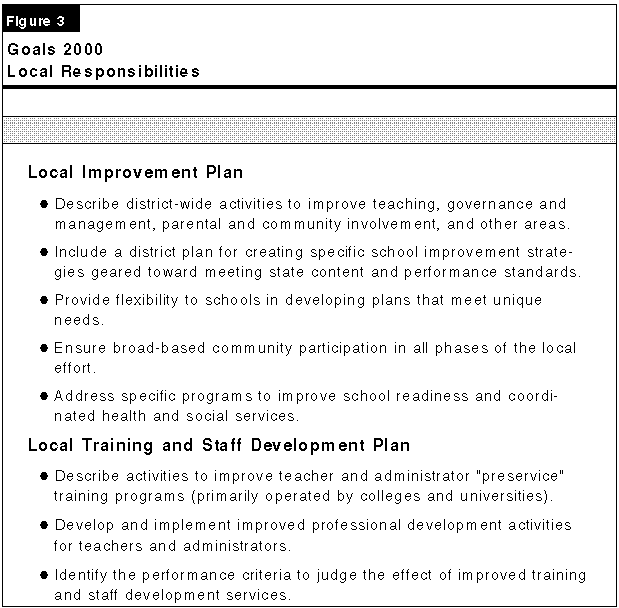
There are few specific local requirements in the federal law. As a result, Goals 2000 provides substantial local flexibility in the way LEAs seek to meet the education goals. This local discretion also means that, if the state's goals are not clearly defined or if its technical assistance support is not adequate, LEAs might pursue activities that do not improve school performance.
Funding
Modest new federal funding is available to California for the implementation of Goals 2000. In 1994-95, $9.9 million was allocated to California. Of that amount, 40 percent, or $4 million, may be used for state implementation activities. If the state uses the full 40 percent for administration, $5.9 million would be available to support local grants. An additional $400,000 was awarded to California for development of the state technology plan.
California has been allocated $36.3 million for 1995-96--a 250 percent increase above the 1994-95 amount. Of that amount, only 10 percent, or $3.6 million, may be used for state administration. The remaining $32.7 million would be available for local grants. In a state the size of California, however, even this amount remains quite modest. By comparison, for instance, the state's School Improvement Program allocates over $300 million annually in support of school-based improvement activities.
Implementation
California has considerable experience with at least three of the program elements contained in Goals 2000.
- Curriculum frameworks developed by SDE may qualify as the state's curriculum standards in many subject areas.
- The state's testing program has focused for the past five years on performance assessments of the type called for in Goals 2000.
- The state also has recognized the importance of staff development by funding the Subject Matter Projects, Bilingual Teacher Training Program and other programs.
The state's experience in these areas will address many implementation questions.
Federal law calls for the creation of a state task panel to develop the state improvement plan. Under federal law, the Governor and the state Superintendent of Public Instruction each appoint half of the panel members. At the time this report was prepared, the panel had not been appointed.
The Goals 2000 Act permits states to begin implementation of the act before appointment of the panel. Based on this feature of federal law, SDE has submitted to the federal government, and received approval for, a Year 1 state plan for the first year of Goals 2000. The Year 1 plan contains little else beyond a commitment to develop a comprehensive plan as required by the act.
The Department of Finance has notified the Legislature that it intends to approve a request by SDE to spend $1.2 million of the Goals 2000 funds. These funds would allow SDE to develop a local grant application, provide technical assistance to LEAs, and support state panel members when they are appointed. No proposal has been made regarding the remaining Goals 2000 funds.
The STWOA focuses primarily on high school reform. Unlike Goals 2000, which contains few detailed mandates for state or local programs, STWOA seeks very specific changes in the high schools. The goal of the program is to involve all high school students in a performance- based education and training program that (1) increases student achievement and, as a result, college attendance, and (2) helps students get better jobs, especially in high-skill, high-wage occupations. Yet, despite the STWOA mandates, the act provides considerable flexibility to states and LEAs in the specific program design.
The act permits states to apply to the federal government for five-year grants to create statewide school-to-work transition "systems." States receiving grants must ensure that local programs contain three program components, displayed in Figure 4. These components are school-based components, work-based components, and connecting activities. The STWOA also creates new authority for the federal Secretaries of Education and Labor to waive program rules in six education programs and in the federal Job Training Partnership Act.
To receive planning or implementation grants, states must apply to the federal government. The application for implementation funding takes the form of a five-year state plan. The requirements of the state plan--and state responsibilities under the act--are described in Figure 5. The plan must be developed by a task force composed of the Governor, the Superintendent of Public Instruction (SPI), state agency officials responsible for economic development, job training, secondary education, and representatives of the private sector.
State duties fall into three general categories. The state is responsible for developing instructional and curricular models for local programs. The federal act also describes a number of state implementation duties, such as identifying local program regions and developing performance standards. States are responsible for coordinating STWOA with other federal education programs and postsecondary programs.
Most of the federal STWOA funds must be used to support grants to local partnerships, which will plan and administer local programs. Partnerships are composed of employers, representatives of LEAs and postsecondary educational institutions, teachers, counselors, representatives of workers, and students. Representatives of other groups also may be included in the partnership. Figure 6 displays the planning requirements that local partnerships will be required to meet in order to qualify for a local grant.
Funding for California's school-to-work effort remains uncertain for two reasons. First, because states must apply to the federal government for a state grant, California is not assured funding. Second, if California's proposal is approved for funding, the amount awarded will depend on the federal appropriation for the STWOA. According to the Employment Development Department (EDD), California will be eligible for about $15 million annually for a five-year period.
In addition to state grants, the federal act permits local partnerships to apply directly to the federal government for funding. The federal government has approved four direct local grants to partnerships in California. San Diego and Tulare County partnerships were approved in August. Partnerships in Compton (Los Angeles) and Riverlake (San Joaquin County) were awarded grants in late November.
A number of programs operated by school districts in California meet most of the STWOA requirements. (Please see our report School-to-Work Transition: Improving High School Career Programs for more detail.) These programs serve very few students, however, and are relatively expensive. Cost is an important consideration as no permanent funding is anticipated through the STWOA. The federal act envisions that local programs will be supported primarily by redirecting existing resources.
California did not apply for an implementation grant for 1994-95. Three state agencies-- the EDD, the SDE, and the Chancellor's Office of the Community Colleges--received a federal planning grant to develop the state's STWOA plan. These agencies intend to apply for an implementation grant for 1995-96. A task force was appointed by the Governor to guide the planning efforts of the three agencies. In addition, input from a wide array of education, training, and employer groups was sought during the planning process.
The Governor released the task force's plan on November 18, 1994. With its release, the plan was available for public review and comment for about 60 days. The task force hopes to submit the plan to the federal government by early May.
The Elementary and Secondary Education: Improving America's Schools Act is not "new" legislation in the same way as Goals 2000 and STWOA. The ESEA has been in effect for almost 30 years. Congress periodically reauthorizes the act, making changes to improve its effectiveness. Below, we discuss the act as reauthorized by Congress in October of 1994.
In contrast to Goals 2000 and STWOA, the ESEA addresses a wide variety of problems and needs. The act contains 14 "titles," or program areas (previous ESEA terminology called these titles "chapters") and authorizes 32 separate funding programs. Figure 7 (next page) displays seven titles that are of particular importance to California.
In reauthorizing the ESEA, Congress made many changes. The new act emphasizes professional development--a separate title for professional development was created (Title 6) and the issue is highlighted within many of the act's other titles. The Title 1 funding formula was amended to increase funding for high poverty schools. Because the funding formula is used to distribute funds in other federal education programs (such as vocational education funds), the change in the formula has major financial consequences for LEAs.
Many of the ESEA changes are similar to policies established in Goals 2000 and STWOA. The Title 1 compensatory education program adopted a performance-based accountability system using content and performance standards similar to the one contained in Goals 2000. Increased emphasis on preschool services, adult literacy, and coordination with health and social services also ties in with Goals 2000. ESEA funds also may be used to support school- to-work programs.
Like Goals 2000 and STWOA, a number of changes afford states and LEAs additional flexibility over the use of funds. States and LEAs are given greater latitude to integrate funding from the many titles and programs within the ESEA. Coordination requirements that parallel those found in Goals 2000 and STWOA encourage states and LEAs to blend ESEA funds with funding provided under a variety of federal programs. Federal waivers are available for many of the ESEA titles.
In addition to the waiver authority, Congress authorized states and LEAs to submit a consolidated plan for most ESEA programs, Goals 2000, STWOA, and the federal vocational education program. This consolidated plan would substitute for separate state plans for each program. States may require LEAs to submit consolidated applications if the state submits to the federal government a consolidated plan. Consolidation of these plans is intended to improve coordination of state and LEA programs.
A description of the state responsibilities for every ESEA program is beyond the scope of this report. For this reason, this section will discuss in detail three of ESEA's programs: the Title 1 compensatory education program, Title 2 professional development, and Title 6 innovative education strategies. A review of these three programs provides a picture of the complexity and variety of ESEA programs.
Figure 8 (next page) displays some of the major state requirements for these three programs. As the figure suggests, the state role in ESEA programs varies considerably. Under Title 1, states will set performance standards, monitor LEA performance based on those standards, and provide support to schools and districts for improving performance. Under Title 2, the state is charged with coordinating programs that provide staff development services. These services are intended to assist teachers in developing the skills needed to help students meet state performance goals. Under Title 6, the state's role is limited to evaluation and resource allocation.
While states have significant responsibilities, LEAs make many important decisions over the allocation and use of funds. Figure 9 describes major local planning responsibilities under the three ESEA programs. Like state responsibilities, federal requirements governing local planning and use of funds varies considerably by program. Title 1 has a number of specific rules governing local program responsibilities. At the other extreme, Title 6 places virtually no limits on how LEAs may use program funds.
Unlike Goals 2000 and STWOA, the ESEA provides substantial funding to California schools. Figure 10 displays 1994-95 and 1995-96 funding for seven ESEA titles. The 1994-95 funding levels are based on the previous version of ESEA. The 1995-96 amounts are based on the reauthorized act.
As Figure 10 (next page) illustrates, California will receive more than $900 million in 1994-95 and more than $1 billion in 1995-96 from the seven ESEA titles. More than two-thirds of the funding allocated by these seven titles is contained in Title 1 compensatory education grants to LEAs. The remaining titles are funded at much lower levels.
Funding for most of the titles will increase in 1995-96. Title 1 will receive the largest dollar increase, experiencing a $39.6 million, or 5.7 percent, increase. Title 2 professional development activities will receive the largest percentage increase in funding, expanding by $12.7 million, or 27 percent, in 1995-96. Future increases in funding for California are likely. Changes made to ESEA funding formulas are expected to result in California receiving a larger share of funds in the future.
Most of the programs and titles within ESEA are not new. States and LEAs are looking at the changes made by Congress to determine the major implementation issues. Because the ESEA reauthorization was enacted by Congress in October 1994, implementation of the changes by SDE is in the early stages.
A couple of important efforts are underway, however. First, the SDE is developing a common vision of the role of assessment, technical assistance, and staff development for the different ESEA programs. The department hopes this task will permit the different parts of the department to carry out federal requirements in a consistent manner. The department also is considering consolidating the state's application for all of the Title 1 programs. While no firm decision has been made, the initial planning for a consolidated application is underway.
According to the department, the Title 1 plan must be presented to the State Board of Education for approval by February 1995. An approved state plan is due to the federal government by May 1995.
While the three federal acts have separate programmatic purposes, they share several common themes and an overarching approach to improving state and local education programs. This section assesses the strengths and weaknesses of the strategy contained in the federal education acts. First, we identify the common themes of the three acts. Second, we discuss how these themes correspond to findings of recent educational research. Third, we discuss the major challenges presented by the federal strategy.
The three new federal acts contain four common themes designed to tie together the programs created by those acts. It is essential to recognize these themes, for they create a new program framework for the implementation of the three federal acts. These four themes are discussed below.
One of the new federal programs--Goals 2000--focuses on school improvement for all students. Instead of a narrowly targeted program, Goals 2000 provides funds to states and school districts to spur reform efforts aimed at improving the overall performance of public education.
In addition, however, the standards set in Goals 2000 will serve as program standards in the STWOA and the ESEA programs. Schools should help all students--including those students who need additional services--meet the state's Goals 2000 standards. In this way, the federal acts attempt to integrate targeted federal programs into the regular program received by all students.
Instead of a process-oriented state and federal oversight role, the new federal acts seek to judge local programs by how well students are educated. Although remnants of the rule- based system remain in the new acts, the new legislation provides new flexibility to help states and LEAs take full advantage of the federal programs. The waiver provisions, in particular, offer substantial new state flexibility.
In return for more administrative flexibility, the federal government is requiring accountability for federal programs through outcome measures. These include:
Figure 11 displays state responsibilities for the activities common to most of the new federal programs. States are required to set content and performance standards and develop model programs and curriculum, which will guide LEA improvement activities. Technical assistance and staff development and training are the tools used to help schools and teachers improve curricula and instruction. State approval of local plans and funding provides state leverage for encouraging local activities which are consistent with state policy.
Consolidated applications and coordination with other federal education programs are designed to reduce the fragmentation of federal programs at the state and local level. For the most part, the acts do not specify how coordination should occur--this question is left to states to answer. Yet the intent is clear: the federal government wants states and LEAs to begin merging federal programs into one integrated program that permits all students to perform at high levels.
The new federal framework presents states with a program structure that holds a greater hope for success in improving student achievement than the existing structure. This is because the acts recognize much of what evaluations of school reform programs have revealed over the last ten years. Specifically, experience has shown that, to improve the education system, program services must translate into better teaching practices and better curriculum.
We discussed many of these issues in our report Reform of Categorical Education Programs. In evaluating state categorical programs, we came to several key conclusions:
The federal acts seem to recognize these findings. Provisions in the new acts reflecting this understanding of the school improvement process include:
Our report on categorical programs developed five principles we believe the Legislature should use in reforming categorical programs. These five principles, shown in Figure 12, are remarkably consistent with the new federal framework. Both seek to clearly identify program goals, use those goals as an accountability structure, and increase local control over the use of funds. Greater coordination and consolidation also is emphasized in both our report and the federal strategy.
While our report was written to help the Legislature in the reform of state categorical programs, we think the state should implement the three federal acts based on these principles. These principles are consistent with the federal strategy and provide a more comprehensive program design checklist. For these reasons, the federal framework offers an important opportunity to improve the implementation of the federal acts and to rethink the state's education system as well.
These principles describe a process for improvement, rather than a recipe for success. As we discuss in the next section, not all of the implementation questions can be answered. As a result, we view the framework contained in the federal legislation and our recommended principles as a long-term process of refining how state and federal governments can most effectively help improve local education programs.
As we described in previous sections, California is far along in developing many of the programs and elements required by the new federal acts. Curriculum frameworks are well- developed; significant experience with state-wide assessments has been garnered over the last 20 years; the state's school-to-work programs are among the more developed in the nation.
Despite California's progress on these issues, implementation of the three federal acts faces significant challenges. The difficult implementation issues that must be addressed range from major strategic questions--such as how to redirect existing bureaucracies to support improvement activities--to individual implementation issues, such as how Goals 2000 funds should be spent. Major challenges facing the state and LEAs are discussed below.
The three acts create more than 35 funding programs, some of which are administered by the state and others that are administered at the federal level. These programs, in addition to existing state categorical programs, create a complex financial and policy environment for LEAs. According to a 1988 SDE report: "[A]dding layers of multiple categorical programs onto the base program without a vision and cohesive strategy has impaired the prospects for significantly narrowing the achievement gap [between special needs students and other students] . . . "1
Reducing this complexity could promote effective implementation by LEAs. For instance, the state could create a less-complex program environment by eliminating or consolidating categorical programs. In addition, SDE could increase local flexibility by coordinating state and federal reforms at the state level, thereby freeing LEAs from that responsibility. Such changes probably would require state legislation and/or federal waivers.
Many different divisions within the State Department of Education --we counted at least six--are directly responsible for administering part of these three federal acts. The department is structured along program lines, which magnifies the importance of specific program issues. As one study commented, "Most [state education] agencies--sectioned into offices corresponding to federal and other special programs--[aren't] well-suited to lead reforms..." For the most part, this comment applies to SDE.2
Similarly, many districts also are not structured to implement the federal strategy effectively. The federal changes highlight the importance of districts in assisting schools in their improvement efforts. Unfortunately, many school districts have adopted a "command- and-control" role over schools, similar to the existing regulatory strategy embedded in most state and federal programs. As a result, many districts will have to adopt a new role, one of supporting school-site improvement efforts.
These challenges to SDE--changing its own role and helping school districts grow into a new role--will require the department to rethink its organization and standard operating procedures. Communication within the agency will have to improve. Regulation development should become less important and technical assistance should become more important. Financial audits should become less common, and program evaluations should become more common.
The new federal acts seek to judge local programs based on specific student outcomes. While focusing on performance rather than process makes sense, at least two potential issues could blunt the effectiveness of this system to improve student achievement:
Educators have almost no good data demonstrating the impact of many educational services. This lack of evaluation data reveals an obvious need for better information on the impact of various school reform efforts. This information is needed to help LEAs design the most effective programs to meet their students' needs.
The state needs to begin a systematic effort to evaluate local program models. It is an appropriate role for the state--the benefits of evaluation are statewide in nature. In fact, we think the audience for evaluation evidence is national. Since program models used in California may be replicated by other states and LEAs, data on effectiveness will have nationwide significance.
This argues for a broader evaluation effort, one in which the federal government and foundations are partners. For instance, federal funding has provided the core support for evaluations of social services programs. Perhaps such a state-federal partnership can be established in K-12 education. This would reduce the cost of evaluations to individual states and, through the federal government, make evaluation findings available to other states and LEAs.
Even if states and LEAs emphasize improvement, local barriers to change will slow the pace of improvement, for a number of reasons. First, educators may resist reform efforts if they believe the quality and rigor of instruction will suffer. This is a particular problem in school-to-work, since vocational education has a lower status among many educators.
Second, schools find the power of "standard operating procedures" very strong. Effective reforms take great effort to develop and carry out. As a result, without strong teacher and parental support, changes are very difficult to effect. Even schools that seek to change often find reform elusive. For instance, in 1991 the Accelerated Schools Project--a national network of schools and educators--surveyed schools a few months after initial intensive training and found that one-third of the project's schools had not taken any actions to initiate reform at the school.
Third, lack of funding may inhibit improvement activities. Reform takes resources-- money to rewrite curriculum, create time for staff development, purchase new materials. Yet the amount of new funding provided in these programs is relatively small. The Goals 2000 and STWOA funding that California is expected to receive is small, relative to the amount needed to help all schools and districts--indeed, STWOA provides no long-term funding at all. In contrast, the Partnership Academy program, one of California's school-to-work programs, provides up to $1,000 per student annually to pay for the additional costs of the program.
These challenges to change will slow improvements to instruction and curriculum unless strong incentives for improvements are built into the state policy and implementation. The whole point of the new federal strategy is restructuring programs and state regulation to create incentives for improvement. The greater the focus the state can place on these incentives--through implementation, through restructuring state categorical programs--the more likely this new strategy can overcome local resistance to change.
Chapter 2
School-to-Work Opportunities Act (STWOA)--High School ReformProgram Components
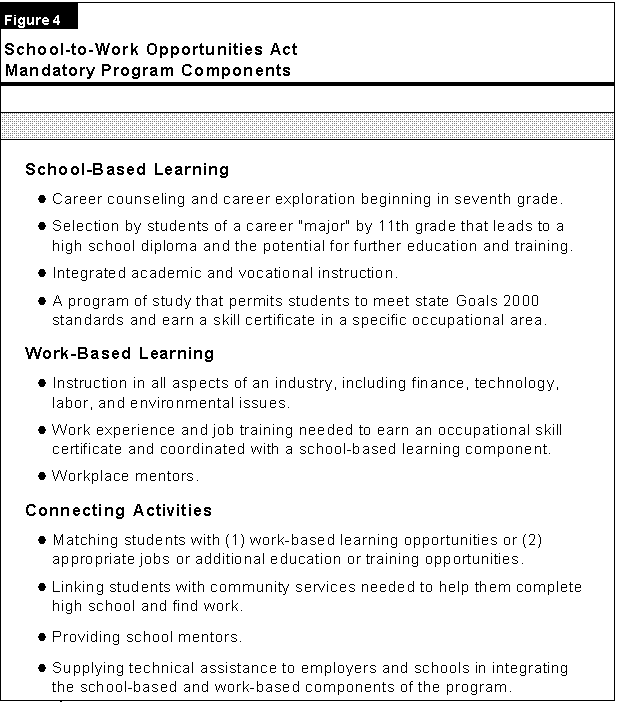
State Responsibilities
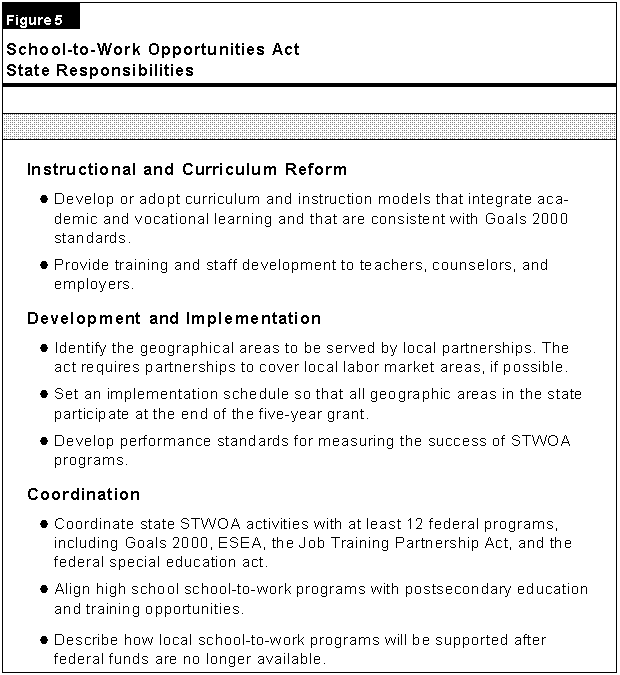
Local Responsibilities
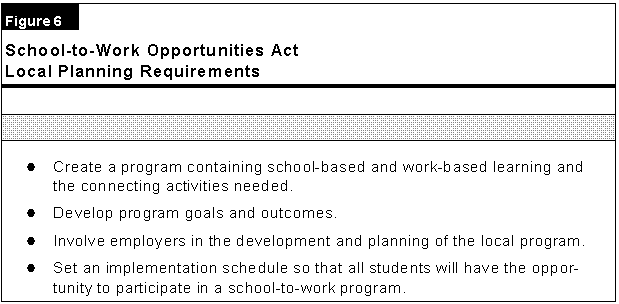
Funding
Implementation
Chapter 3
Elementary and Secondary Education Act (ESEA)ESEA Program Components
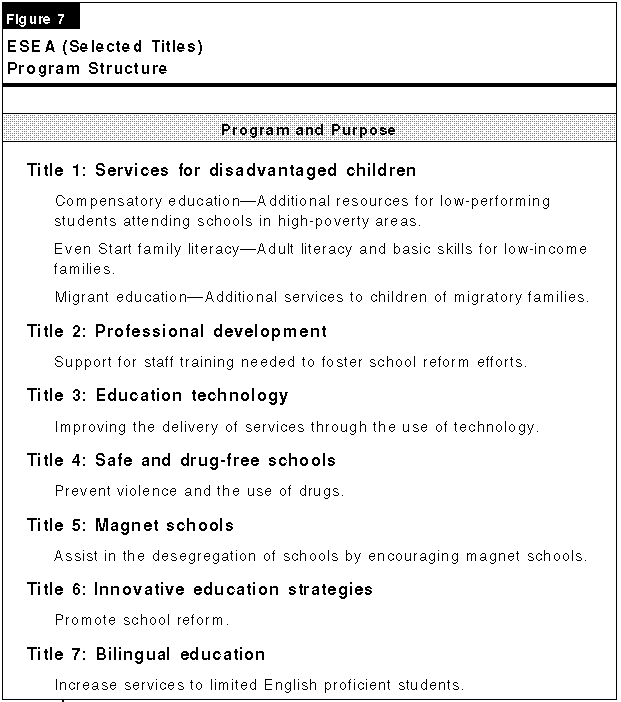
State Responsibilities
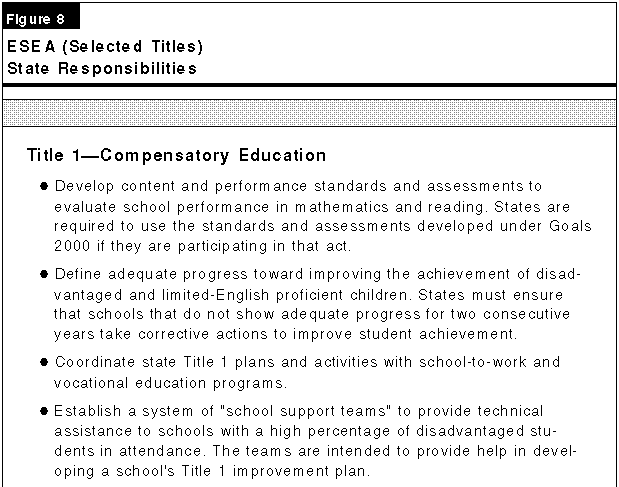
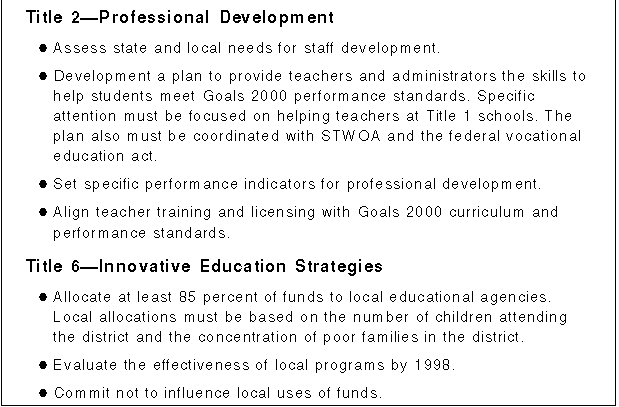
Local Responsibilities
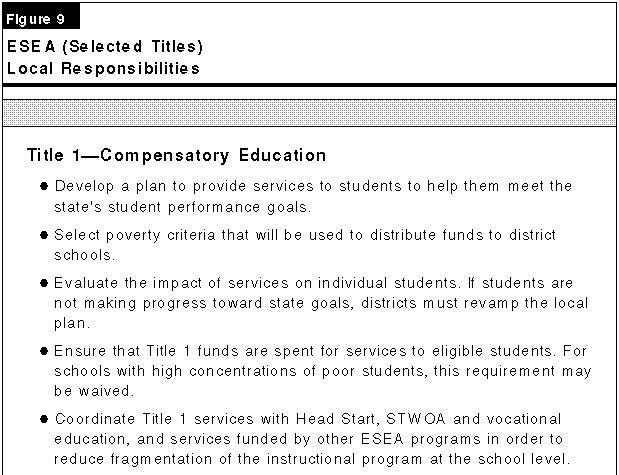
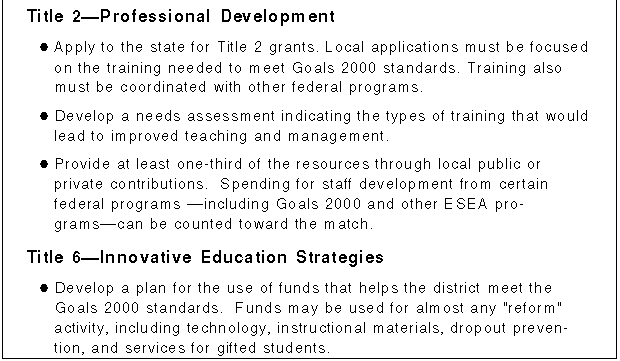
Funding

Implementation
Chapter 4
An Assessment of the Reform Strategy in the New Federal ActsCommon Themes in Federal Categorical Programs
Setting Goals for What All Students Should Learn
A New Regulatory Strategy Based on Performance
A Common Set of Improvement Activities
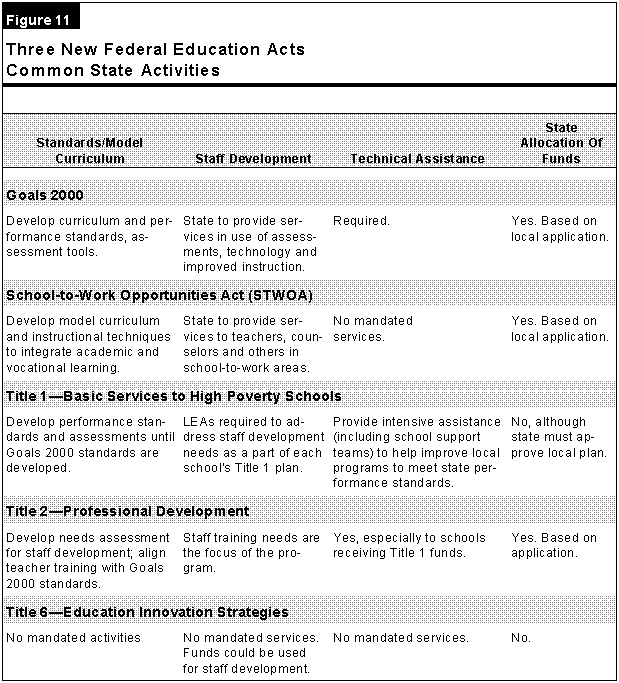
Coordination Among Federal Education Programs
New Federal Framework Recognizes Evaluation Findings
Principles for Program Design
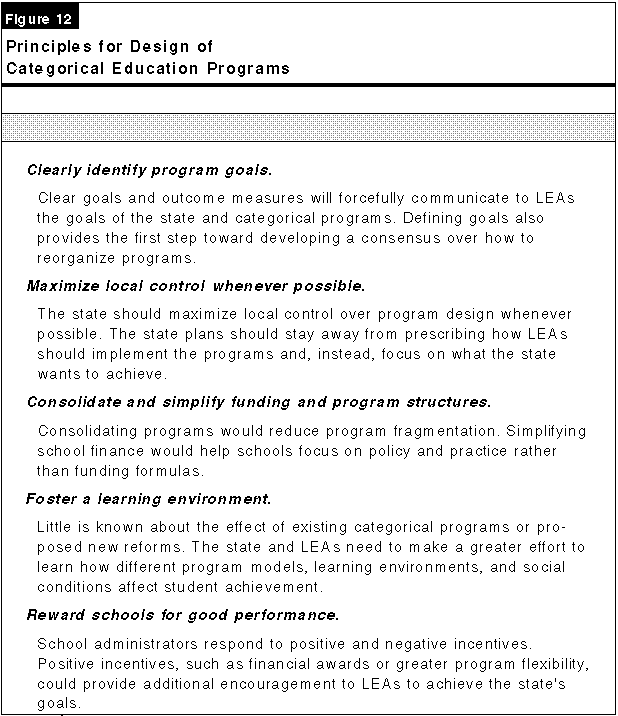
Significant Challenges to Effective Implementation Exist
Complex Web of State and Federal Programs Remain
The SDE and Many LEAs Are Not Well-Structured to Implement Acts
Performance-Based Regulation Is Unproven
Little Solid Evaluation Data Exists to Guide Local Improvement Efforts
Barriers to Change Will Remain
 Legislative Analyst's
Office, February 1995
Legislative Analyst's
Office, February 1995
